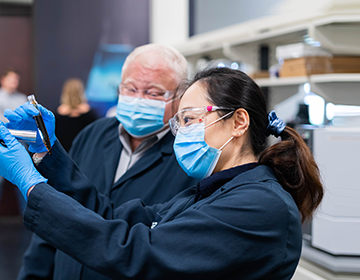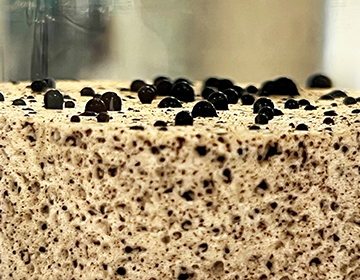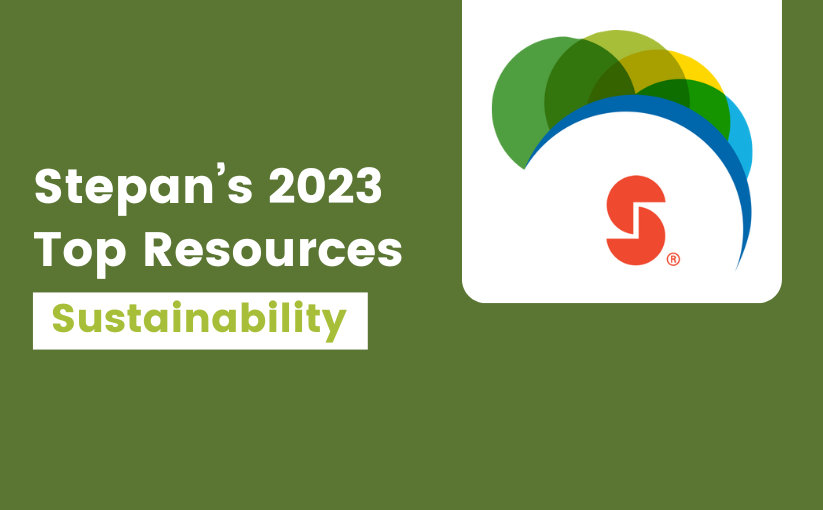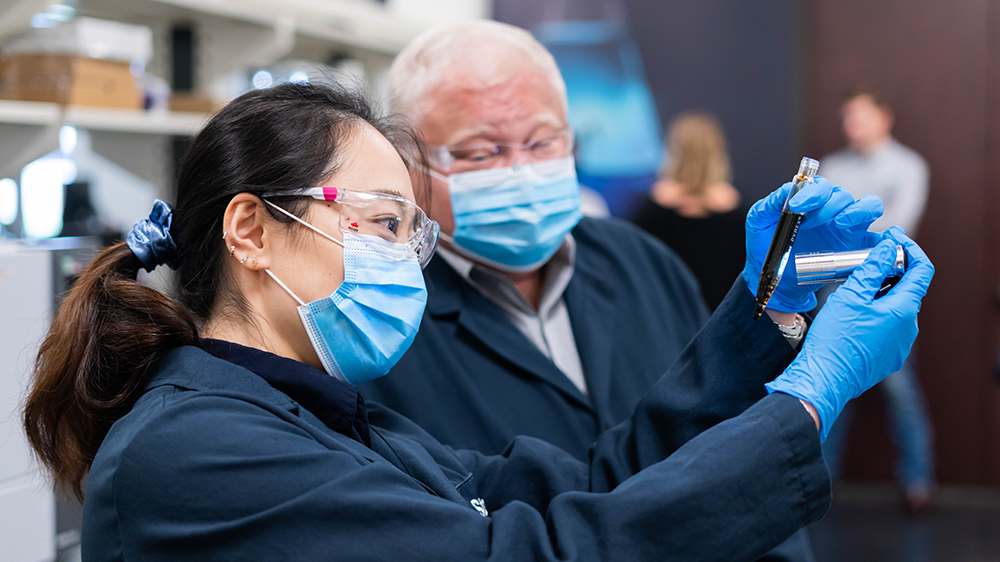Whether you are in Europe, the Middle East, Africa or Russia, the Stepan Oilfield Solutions team in Europe works diligently to solve challenges that are unique to the upstream market. Our dedicated team can help you protect your assets, save money and optimize your business. Together, we can bring value to the surface. Watch the video to learn more.
Oilfield
Meet the Stepan Oilfield Solutions Europe Team
Demulsifier Resins
The PETROSTEP KB-2400 Series resins have water separation properties that make them an idela component in demulsifier blends for upstream, midstream and downstream application for a wide range of crude oils and other liquid hydrocarbon/water emulsions.
Spontaneous Imbibition Solutions
Spontaneous imbibition is a less expensive and less complex solution for situations when the matrix rock is oil-wet and formation water is not readily imbibed into the rock in a spontaneous process. We provide customized surfactant systems for spontaneous imbibition that help optimize your well treatments.
Explore Our Products and Systems
Production Solutions
Stepan Oilfield Solutions offers a robust oilfield chemicals portfolio your production needs. Our PETROSTEP® product line is backed by science and application experts.
Demulsifiers
Stepan Oilfield Solutions provides proven demulsifier intermediates to upstream and downstream challenges. Our acquired line of KMCO’s trusted demulsifier intermediates will help service companies deliver consistent field performance with their formulated products.
- The PETROSTEP KB-2400 Series resins have water separation properties that make them an ideal component in demulsifier blends for upstream, midstream and downstream applications in a wide range of crude oils and other liquid hydrocarbon/water emulsions.
- PETROSTEP KB-3208 is a polyglycol ester that is effective in a large variety of crude, processed and refined oils in operations worldwide.
- PETROSTEP KB-1303 is an oxyalkylated triol or poloxyalkylene glycerol designed to effectively demulsify a wide variety of crude, processed and refined oils in operations worldwide.
- PETROSTEP KB-1410 is an oxylkylated amine designed to effectively demulsify a large variety of crude oils worldwide.
- PETROSTEP KT-1231 is an alkyl arylsulfonic acid in aromatic hydrocarbon designed to effectively demulsify a large variety of crude, processed and refined oils in operations worldwide.
- PETROSTEP KW-115 is a fatty ester of a medium molecular weight copolymer designed to effectively inhibit crystal formation in hydrocarbons.
Our PETROSTEP CI products are designed to meet a wide range of application needs — from pipelines to production and injection wells, to storage tanks, pumps and treatment units.
We also offer a variety of water-soluble corrosion inhibitor concentrates for continuous and batch treatment applications.
For those looking for more environmentally friendly chemistries, Stepan's novel green corrosion inhibitors are excellent corrosion inhibitor intermediates for the production market. This patent-pending technology provides superior performance to help customers secure their assets' integrity while keeping sustainability in mind. Request the Green Corrosion Inhibitors case study to learn more.
Our PETROSTEP PE-1 is a finished blend that enhances oil production from mature wells. It is compatible with oilfield fluids, including heavy brines and 15% hydrochloric acid.
Our formulated concentrates work on the toughest oilfield soils. Contact us today to find the best solution.
Stepan Oilfield Solutions’ dispersant products are designed to be used for dispersing waxes, asphaltenes and sludges during production and cleanout operations.
Our PETROSTEP SI-1 is a proven inorganic scale inhibitor. In Dynamic Scale Loop Tests (DSLT), it outperforms other commercially available products in preventing scale build-up.
We offer a broad range of temperature, salinity and oil-tolerant foaming agents.
Registered Biocides
Our PETROCIDE® Registered Biocides eradicate and prevent harmful bacterial growth in various stages of oil and gas production. They have been shown to be effective against free-floating bacteria and biofilm colonies of varying anerobic bacteria species. Watch our webinar on our U.S. EPA-registered biocides to learn more.
Let us customize a solution for your specific application. Contact us today.
Exploration Solutions
Stepan Oilfield Solutions offers a range of products to provide formulators numerous options for meeting their application performance requirements. :
Emulsifiers and Wetting Agents
Our emulsifiers create an emulsion of two immiscible liquids, and wetting agents that wet solids.
PETROSTEP® WA-9 provides effective solids wetting and degreasing properties for a wide range of oilfield applications. It also reduces environmental impact as it does not contain any alkylphenol ethoxylates (APE), specifically nonylphenol ethoxylates, making it an ideal replacement, without sacrificing performance.
Drilling Mud Recycling
Our surfactant blends remove residual oil from spent drilling mud.
Wellbore Cleaners
Our high salinity-tolerant surfactant blends remove drilling mud and leave water-wet surfaces for cementing.
Cement Foamers
Our foaming agents for cement create uniform bubble density and are compatible with oilfield cement formulations.
Contact us today to discuss your exploration needs.
Stimulation Solutions
Stepan Oilfield Solutions can tailor specialized components and formulated solutions for stimulation. Our suite of products include:
Our PETROSTEP FRB-5 has been shown to improve friction reduction performance with anionic and cationic emulsion friction reducers (FRs) in harsh water conditions. It has also been shown to boost FRs in water containing up to 265,000 mg/L total dissolved solids (TDS).
Download the PETROSTEP FRB-5 Brochure or watch the WorldOil ShaleTech™ Hydraulic Fracturing Forum webcast recording of "Boosting the Performance of Friction Reducers," presented by Aaron Sanders, Ph.D., R&D Technical Director, Stepan Oilfield Solutions, to learn more.
These products create emulsions of solvents with acids for acid stimulation and spearheads.
Our PETROSTEP® ME-2 flowback aid is an exciting new technology developed to increase flowback from hydraulic fractures and enhance the well's oil productivity. These were designed to remediate as many of the ways fracturing fluid can damage the formation. Watch our latest webinar to learn more.
PETROSTEP ME-2 flowback aid can also be used for gas well condensates to help operators improve hydrocarbon production by enhancing the clean-up of fluids after stimulation. Download the PETROSTEP ME-2 Flowback Aid for Gas Well Condensates brochure to learn more.
These surfactants help hydrate water-soluble polymers such as guar and polyacrylamide.
Our PETROSTEP NE Series helps prevent emulsions from forming and ensures that wells can operate at their optimum performance.
Our PETROCIDE® Registered Biocides eradicate and prevent harmful bacterial growth in various stages of oil and gas production. They have been shown to be effective against free-floating bacteria and biofilm colonies of varying anaerobic bacteria species. Watch our webinar on these U.S. EPA-registered biocides to learn more.
We have an extensive product line for creating desired rheologies for frac fluids and other applications under a variety of conditions. Learn more about our PETROSTEP VES-1, PETROSTEP VES-2, PETROSTEP VES-X and PETROSTEP GQ-22 (only available inf the Middle East) viscoelastic surfactants.
Our technical experts can work with your existing system to quickly tailor a solution for your specific application. Contact us today.
EOR/IOR Solutions
Do you have an EOR/IOR project? Ask us about our EOR/IOR offerings, including:
Spontaneous Imbibition Solutions
Stepan Oilfield Solutions provides customized surfactant systems for spontaneous imbibition that help optimize your well treatments. Spontaneous imbibition is a less expensive and less complex solution that is ideal for situations when the matrix rock is oil-wet and formation water is not readily imbibed into the rock in a spontaneous process.
Watch our workshop on spontaneous imbibition to learn more.
Low Interfacial Tension (IFT) Surfactants
These surfactants are designed to lower oil/brine IFTs across a broad range of salinities and temperatures.
Wettability Alteration Aids
Our surfactants can be used to modify the wettability of mineral surfaces and aid oil mobilization.
Foam Conformance
We offer solutions for near well bore and far field applications, covering temperatures up to 275°C.
Contact us to learn more about our EOR/IOR products.
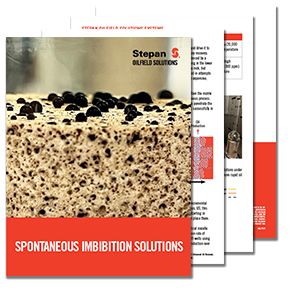
Publications and Case Studies
The Stepan Oilfield Solutions Center of Excellence in Houston, Texas, houses a team of application experts who focus on field-use formulations that help solve problems encountered in hydraulic fracturing and production fluids. Contact us today to access our case studies below and learn how surfactant science can make a difference in your operations.
Enhancing the Performance of Emulsion-based Friction Reducers
PETROSTEP® Friction Reducer Boosters (FRBs) are surfactant formulations that enhance the performance of emulsion-based friction reducers (FRs) in brines. They enable operators to formulate their fracturing fluids in recycled and produced waters, resulting in lower cost and more sustainable operations. This case study demonstrates how our PETROSTEP FRB-5 enables low cost freshwater friction reducers to function like more expensive salt-tolerant friction reducers.
Click here to request the Friction Reducer Boosters case study
Innovative Biodegradable Intermediates for Sweet Corrosion Inhibitors
The corrosion of carbon steel tubing, pipelines and process equipment during oil and gas production due to salt water saturated by corrosives gases, such as carbon dioxide and hydrogen sulphide, can lead to substantial environmental and economic consequences. One of the proven and most widely used corrosion mitigation techniques is the addition of film-forming corrosion inhibitors into production streams. The products used offshore and released in the North Sea are currently controlled by the OSPAR Convention and are required to meet environmental criteria on three parameters: biodegradability, toxicity and bioaccumulation. Stepan’s new PETROSTEP Green Corrosion Inhibitors (GCI) are excellent corrosion inhibitor intermediates for the production market. Stepan's patent-pending technology provides superior performance to help customers secure their asset's integrity. External testing on PETROSTEP GCI-1 also showed that it exhibits good biodegradability in marine water and its high molecular weight makes it a non-bioaccumulant.
Click here to request access to the Green Corrosion Inhibitors case study
An Ounce of Prevention is Worth a Pound of Biofilm Mitigation
Microbial-induced problems in oil and gas incur high costs and cause severe environmental and safety concerns. Most of these problems are directly caused by surface-adhered bacteria colonies known as biofilms. This initial study measured the performance of biocides containing two types of quaternary ammonium compounds and blends with glutaraldehyde were evaluated against sulfate reducing bacteria (SRB) and acid producing bacteria (APB) in planktonkic and sessile forms.
Visualization of Flowback Aid Mechanisms Utilizing a Microfluidic Pore-Scale Device
Slickwater fracturing fluids are commonly used in oilfield to create fracture networks in tight rocks to promote oil and gas production. These fluids employ friction reducers to reduce friction pressure and allow faster injection and lower pumping pressure. However, polymer residue from friction reducers can reduce the permeability of tight rocks during flowback. To help understand the damage mechanisms of friction reducers and their remediation, this study looked at the dynamics of fluid behavior in unconventional resources by combining coreflood and microfluidics-based measurements. Through this combination, the researchers were able to gather quantitative results and visualization.
A Novel Method to Evaluate Ability of Surfactants in Slickwater Fluids to Minimize Formation Damage and Optimize Hydrocarbon Recovery after Hydraulic Fracturing
In recent years, use of slickwater fracturing fluids has emerged as a standard practice in fracturing U.S. shale reservoirs. Using less proppant and fewer components than traditional fracturing fluid systems, slickwater systems have greater fracture-conductivity than similar guar-based systems. With the adoption of this new technique, a key area of interest is in assessing the impact of surfactant additives on improving permeability and maximizing hydrocarbon recovery. This study examines the ability of surfactants to mitigate permeability impairment in a slickwater system.
Enhancing Friction Reducer Performance in High Salt Conditions
Friction reducers are an essential part of hydraulic fracturing, allowing pumps to push fluids at faster rates using less horsepower. The polyacrylamide friction reducers typically used in this application are sensitive to dissolved solids, which is particularly important as operators begin to use more produced water and freshwater sources become more expensive or unavailable. This study details a series of experiments using a friction flow loop to observe the effect of dissolved cations on friction reducer performance. A surfactant system was shown to be effective in preventing performance degradation in saline water and extending the salt tolerance of a friction reducer.
Recently Viewed


